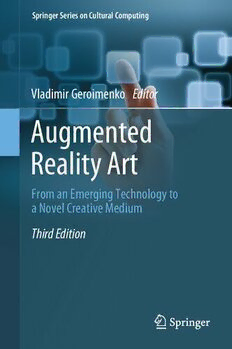
AUGMENTED REALITY ART from an emerging technology to a novel creative. PDF
Preview AUGMENTED REALITY ART from an emerging technology to a novel creative.
Springer Series on Cultural Computing Vladimir Geroimenko Editor Augmented Reality Art From an Emerging Technology to a Novel Creative Medium Third Edition Springer Series on Cultural Computing FoundingEditor ErnestEdmonds SeriesEditor CraigVear,DeMontfortUniversity,Leicester,UK EditorialBoard PaulBrown,UniversityofSussex,Brighton,UK NickBryan-Kinns,QueenMaryUniversityofLondon,London,UK DavidEngland,LiverpoolJohnMooresUniversity,Liverpool,UK SamFerguson,UniversityofTechnology,Sydney,Australia Bronac˙ Ferran,Birkbeck,UniversityofLondon,London,UK AndrewHugill,UniversityofLeicester,Leicester,UK NicholasLambert,Ravensbourne,London,UK JonasLowgren,LinköpingUniversity,Malmo,Sweden EllenYi-LuenDo ,UniversityofColoradoBoulder,Boulder,CO,USA SeanClark,DeMontfortUniversity,Leicester,UK Moreinformationaboutthisseriesathttps://link.springer.com/bookseries/10481 Vladimir Geroimenko Editor Augmented Reality Art From an Emerging Technology to a Novel Creative Medium Third Edition Editor VladimirGeroimenko FacultyofInformaticsandComputerScience TheBritishUniversityinEgypt(BUE) SheroukCity,Cairo,Egypt ISSN 2195-9056 ISSN 2195-9064 (electronic) SpringerSeriesonCulturalComputing ISBN 978-3-030-96862-5 ISBN 978-3-030-96863-2 (eBook) https://doi.org/10.1007/978-3-030-96863-2 1stedition:©SpringerInternationalPublishingSwitzerland2014 2ndedition:©SpringerInternationalPublishingAG2018 3rdedition:©SpringerNatureSwitzerlandAG2022 Thisworkissubjecttocopyright.AllrightsarereservedbythePublisher,whetherthewholeorpartof thematerialisconcerned,specificallytherightsoftranslation,reprinting,reuseofillustrations,recitation, broadcasting,reproductiononmicrofilmsorinanyotherphysicalway,andtransmissionorinformation storageandretrieval,electronicadaptation,computersoftware,orbysimilarordissimilarmethodology nowknownorhereafterdeveloped. Theuseofgeneraldescriptivenames,registerednames,trademarks,servicemarks,etc.inthispublication doesnotimply,evenintheabsenceofaspecificstatement,thatsuchnamesareexemptfromtherelevant protectivelawsandregulationsandthereforefreeforgeneraluse. Thepublisher,theauthorsandtheeditorsaresafetoassumethattheadviceandinformationinthisbook arebelievedtobetrueandaccurateatthedateofpublication.Neitherthepublishernortheauthorsor theeditorsgiveawarranty,expressedorimplied,withrespecttothematerialcontainedhereinorforany errorsoromissionsthatmayhavebeenmade.Thepublisherremainsneutralwithregardtojurisdictional claimsinpublishedmapsandinstitutionalaffiliations. ThisSpringerimprintispublishedbytheregisteredcompanySpringerNatureSwitzerlandAG Theregisteredcompanyaddressis:Gewerbestrasse11,6330Cham,Switzerland Thispioneeringbookisdedicatedtothe futuregenerationsofaugmentedreality artists. InthememoryofMr.MohamedFarid Khamis(1940–2020), thefounderofthe BritishUniversityinEgypt. Preface Thebookyouareholdinginyourhandsinapaper,ormorelikelydigital,formatis auniqueone.Thisisthethirdeditionofthefirstevermonographthatexploresthe excitingfieldofaugmentedrealityartanditsenablingtechnologies.Itiswrittenby a team of world-leading artists and researchers, pioneers in the use of augmented realityasanovelartisticmedium,andisbeingdedicatedtothefuturegenerations ofaugmentedrealityartists. This book explores a wide range of major aspects of augmented reality art and related technologies. It is intended to be a starting point and essential reading not only for artists, researchers and technology developers, but also for students and everyonewhoisinterestedinemergingaugmentedrealitytechnologyanditscurrent andfutureapplicationsinart. It was difficult to make this book happen, because augmented reality art is still initsinfancy,andtherearethereforerelativelyfewresearchmaterialsavailable.We oweadebttoourcontributorswhohavemanagedtoproducethismonographinthe faceofthesedifficulties.Ourvirtualteamincludes33researchersandartistsfrom11 countries(Australia,China,Egypt,Germany,Ireland,Norway,Portugal,Romania, Slovenia,UKandUSA). Theneweditioncanbeconsideredaspartofaseriesofsevenpioneeringmono- graphspublishedbySpringeronthesamesubjectofaugmentedrealityandwiththe sameeditor: 1. Augmented Reality Art: From an Emerging Technology to a Novel Creative Medium.GeroimenkoV(Ed),Springer,2014 2. Augmented Reality Art: From an Emerging Technology to a Novel Creative Medium. Geroimenko V (Ed), 2nd Edition, Revised and Updated, Springer, 2018 3. AugmentedRealityGamesI:UnderstandingthePhenomenonofPokémonGO. GeroimenkoV(Ed),Springer,2019 4. Augmented Reality Games II: The Gamification of Education, Medicine and Art.GeroimenkoV(Ed),Springer,2019 vii viii Preface 5. AugmentedRealityinEducation:ANewTechnologyforTeachingandLearning. GeroimenkoV(Ed),Springer,2020 6. AugmentedRealityinTourism,MuseumsandHeritage:ANewTechnologyto InformandEntertain.GeroimenkoV(Ed),Springer,2021 7. Augmented Reality Art: From an Emerging Technology to a Novel Creative Medium. Geroimenko V (Ed), 3rd Edition, Revised and Updated, Springer, 2022 Thebook’s21chapters,whichcanbereadinsequenceorrandomly,arearranged in4partsasfollows. Part I “The Theoretical Aspects of Augmented Reality Art and Technology” includes5chapters(Chaps.1–5). Chapter1“ARTforArtRevisited:AnalysingTechnologyAdoptionThroughAR Taxonomy for Art and Cultural Heritage” states that understanding how effective technologyadoptionisandhowwellopportunitiescreatedbyadvancesintechnology areutilizedisvitalforsupportingadoptionanddevelopmentoftechnology.Tothis end the authors propose an activity-based taxonomy method designed to produce technology adoption insights. The method is applied on adoption of augmented reality(AR)technologyinthecontextofartandculturalheritage.Throughthisthe authors build an AR taxonomy for art and cultural heritage which they then used toclassify119ARapplicationsinthisdomain.Theresultsofclassificationprovide meaningfulinsightintotechnologyadoption,andhowitchangedcomparedtoreports inthepreviouseditionofthisbook.Tonameafew:(i)generallackofsupportfor communication and personalization activities persist; (ii) the quality of adoption remainsbelowsatisfyinglevel,yetsomeimprovementshavebeenmadewithinthe pastfewyears;(iii)despitelimitedimmersioncapacity,handheldARsystemspersist tobethemostcommonlyusedsystems;and(iv)irrespectiveofdifficultandcostly setups a substantial proportion of classified systems represent spatial AR systems; yetthisratiorecentlydroppedduetothehigheradoptionofhead-mounteddisplay systems,whichislargelylimitedtotheresearchdomain. Chapter2“MakingSenseofARt:AMethodologicalFrameworkfortheStudyof AugmentedRealityArt”(anewchapterinthisedition)beginswithanassertionthat overadecade,artistsandcreatorshaveleveragedaugmentedrealitytechnologyto protestandreimaginetheirphysicalworldsthroughsociallyandpoliticallyengaged augmented reality art (ARt). This critical corpus of works is an important, though underexplored,dimensionoftheARtisticcanon,andofthegenealogyofaugmented realitytechnology.Tofacilitatedeeperethnographicengagementwithtoday’scritical ARtpractices,thischapteraddressesamethodologicalgapinthedigitalethnogra- pher’s toolkit by providing a medium-specific approach to the study of ARt. With thisframework,termed“criticalsensoryethnography”,thischapterdemonstratesthat embodied,immersiveexperienceisasociallyandpoliticallysalientphenomenonthat necessitatesongoing,criticalstudy.Toillustratethisapproach,thechapterconcludes withacasestudyfeaturinganARmemorialtoGeorgeFloydcreatedbyAmerican artistStevenChristianinsupportoftheBlackLivesMattermovement. Preface ix Chapter3“WhyWeMightAugmentReality:Art’sRoleintheDevelopmentof Cognition”isbasedonanassumptionthatartservesaneurologicalrole,shapedby evolution.Art,notasathingthatis,butasafunctionthatoccurs,whichtheauthor callsBehaviouralArt(BA).AnimportantaspectofBAis“borrowingintelligence” fromahumanlyorganizedsource,suchasapainting,appliedtoacomputerprocess. The resulting artefact of this auto-creative process might easily be mistaken for an object de (computer) art. But the author looks further into the larger dynamic system,onethatincludestheaudienceaswell.Ashediscusses,themachineitselfis incapableofmeaningfulorganization(i.e.,alphabeticalorderisanarbitraryscheme to a machine.) A human (often the programmer) must supply the organizational paradigmtotheinput,andahumanmustrecognizeoneintheoutput.However,by integratingresourcesfromtheenvironmentviamachine,aprocesswecannowcall augmentedreality.Wemightimbuewhateverqualitytriggeredaninterpretationof “potentially meaningful” in audience members regarding the off-screen image, to our computed output. In this chapter, the author addresses how and why humans tendtoemploythissubtleparticularformofnonverbalexpression. Chapter 4 “Shifting Perceptions—Shifting Realities—Shifting Spheres” (a new chapterinthisedition)showcasesajourneyofcreativeexpressionusingaugmented realityasexperientialcommentaryonsocio-economicconditions.TheARjourney beginsonearthandtakestheartisttothemoon.Ononehand,ontheearth,anARheart islocatedatalocalparkduringOccupy,aninternationalprogressivesocio-political movement.TheubietyoftheARartprovokedanintimateencounterwithalocalpark patronthatillustratesthemultiplicityofrealitiesrelatedtotechnology,environment, poetryandsocio-economiccircumstances.Thechapterexpandsonamomentwhen theartworkprovokesadialogueandbecomessocialtheatreinBloomington,atown in Indiana USA. “heARt to heARt”, the AR art is a pointer to a personal cultural historyandextendsarevolutionary’sportraitintotheworldwhichinturncreatesa poeticencounterduringthesocio-economicstormoftheOccupymovement.ARart wasexperiencedincitiesallovertheworldfromNewYorktoitsperilousappearance inShanghai,China.Andontheotherhand,onthemoon,the“SeedRobots”plan, organizeandbuildaperson’slunarcomfortzoneintheMoonLustexhibitionthat exploresglobalinterestsandissuespertainingtolunarexplorationandhabitation. Chapter5“AugmentedReality,theExpansiveObject,andtheVivificationofthe MemoryTheatre:FieldNotes”(anewchapterinthisedition)considersaugmented reality as an Instant semiotic which begins to problematize, explore, and enlarge theconnectionsbetweenpeople,systemsandthings.Thediscussedartworksarea reified memory theatre, a destabilizing mélange of subjectivities loosely hung on the framework of the works’ object-ness. These are portals, parasites and libraries ofimaginationandthought.Defining“object”and“augmentedreality”impliesthat ARrepresentstheconsolidationofaworldinwhicheachlocation,target,objector sceneistaggedortransformedintoalink.Thisnewtechnologyisatool,atechnique and an interaction but also liberally reflects inquiries of other fields. We see the musingsofspeculativerealismandarenewedfocusonthereifiedobjectinaugmented reality.Andyet,thenotionofamemorytheatreormemorycode,anancienttoolof humancognition,mightbethemostexplicitmetaphorforaugmentedreality.Thenew x Preface technology updates thememory theatreas anextreme spatialization ofknowledge and experience mapped upon location through digitization. This chapter provides thefieldnotesoftheuseofaugmentedrealityintwoexhibitions,ClownTown(2016) andSyntheticCells:Siteand(Para)Site(2018). Part II “Augmented Reality Art and a Variety of Spaces” comprises 6 chapters (Chaps.6–11). Chapter 6 “Critical Interventions into Canonical Spaces: Augmented Reality at the2011VeniceandIstanbulBiennials”describesaugmentedrealityinterventions led by the author Tamiko Thiel in 2011 with the artist group Manifest.AR at the VeniceBiennale,andincollaborationwiththedesignofficePATTUattheIstanbul Biennale. The interventions used the emerging technology of mobile augmented reality to geolocate virtual artworks—visible for viewers in the displays of their smartphonesasoverlaysonthelivecameraviewoftheirsurroundings—insidethe normally curatorially closed spaces of the exhibitions via GPS coordinates. Our interventions used the site-specific character of the technology to create works of artthatstandindialoguewiththesitesandwillretaintheirrelevancelongafterthe biennialsareover.Thesitefiguresasthecanvasfortheartworksandformsanintegral visualandcontextualcomponentofeachartwork.Unlikephysicalartinterventions, theartworkscannotberemovedorblockedbythecuratorsorotherauthoritiesand willremainatthoselocationsaslongastheartistdesires.Theartworksexploitthe site-specificityasanintegralpartoftheartworkwhilesimultaneouslyquestioningthe valueoflocationtocanonizeworksofart,andthepowerofthecuratorasgatekeeper to control access to the spaces that consecrate works of art as part of the high art canon. Chapter7“MergingSpaces:AugmentedReality,TemporaryPublicArt,andthe ReinventionofSite”(anewchapterinthisedition)exploreshowaugmentedreality hasredefinedtemporary,site-specificpublicart,expandingthefieldbyintroducing new practices, and offering possibilities for public engagement that did not exist before. The chapter investigates temporary and site-specific public art before AR technology, then looks at Broadway Augmented—an innovative early augmented realitypublicartprojectlocatedinSacramento,California—andfinisheswithrecent projectsthatexemplifyhowthefieldhasexpanded.DevelopmentsinARtechnolo- gies, mobile devices and ubiquitous networks have meant that augmented reality artcanhaveanimmediatepublicpresence,respondingtosocial,environmentaland culturalissuesasthey areunfolding, making ittheideal formofpublic artforthe twenty-firstcentury. Chapter 8 “Data Narratives: Aesthetic Activation of Urban Space Through Augmented Reality” (a new chapter in this edition) discusses Data Narratives, a commissionedaugmentedrealityartworkresultingfromaperiodasartistinresidence withDublinCityDashboard.DataNarrativesfocusedonworkingwithcitydatato createhybridartisticrepresentationsofDublin’songoinghousingaffordabilitycrisis, actingbothasactivistartisticengagementwiththesocio-political-economicspace of the city and aesthetic activation of urban space through augmented reality. As datadescribesanddefinessomuchofourdigitaleveryday,theprojectandresidency programmeaskedhowitcouldbeleveragedasamediumforartisticcreationandhow
